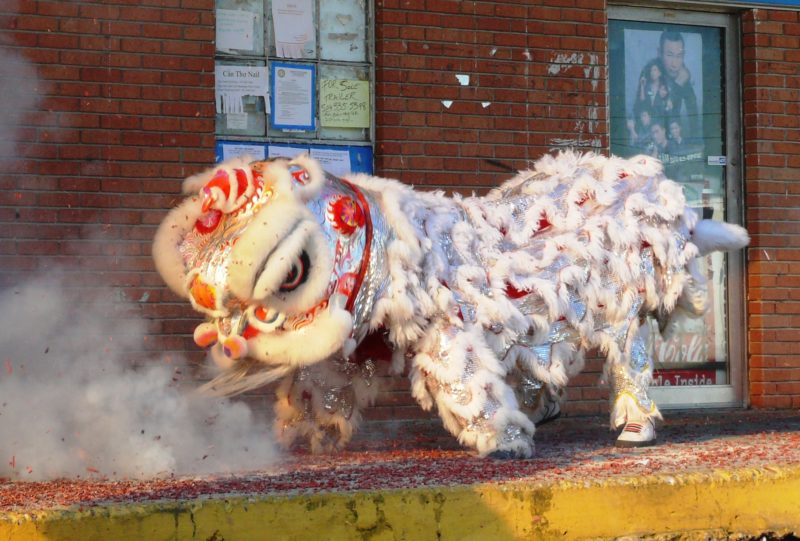Tet Nguyen Dan, otherwise known as Tet, is the Vietnamese celebration of the New Year. This celebration follows the lunar calendar which is based on moon cycles. According to the Julian calendar, the celebration can occur anytime between January and February (Kronowitz, Ellen L. “Creating new images of Vietnam: Celebrating Tet in the middle-school classroom.” Social Studies 86, no. 1 (January 1995): 29. Professional Development Collection, EBSCOhost (accessed April 21, 2014)). While this festival originated in Vietnam, Tet celebrations can be found in other parts of the world, particularly in southern Louisiana. In Louisiana, Tet celebrations occur in three major locations: New Orleans East, Algiers (Westbank), and Marrero. These celebrations are rather large and diverse; New Orleans East alone boasts over 20,000 participants every year (Nguyen, Lac (event coordinator). Interview by Minzala Mvula. Personal interview. New Orleans, April 9, 2014).
History
The celebration of the Lunar New Year is common in many East Asian countries; this practice originated in China. However, different countries incorporate unique cultural aspects to the celebrations (“The Vietnamese New Year.” Tet Nguyen Dan, Accessed April 5, 2014. Web). In Vietnam, the words Tet Nguyen Dan literally translate to “the first morning of the first day of the new period.” It is a three day celebration. New Year ‘s Day is considered the luckiest day of the year. Tet represents new beginnings; “it is a time for family gatherings, paying off debts, mending broken relationships, reconciling conflicts and bad feelings, and wearing new clothes” (Kronowitz). Tet first came to south Louisiana in 1976. This was right around the time many Vietnamese people were coming to the US to escape the communist regime at the end of the Vietnam War (Nguyen).
Regional Significance
There are three major reasons for celebrating Tet in Louisiana. The first is to give the community a chance to gather and celebrate. There is a vibrant Vietnamese community in south Louisiana that organizes the three day festival at Mary Queen of Vietnam Church. At the celebration in New Orleans East, there are more than 20 booths that showcase aspects of Vietnamese culture and the community positioned in New Orleans. The booths offer authentic foods, games, and artistic expressions to all who visit. During the celebration, Vietnamese American singers are invited to perform. About 13 or 14 singers are invited each year. The invited artists include Minh, Tuyet, Nhuloan, and Khanly (Nguyen). Beyond simply the festival, Tet is also an opportunity for families to come together. Sometimes family members from other US states come to Tet festivals in South Louisiana to celebrate because the Vietnamese community is particularly large. During the New Year’s celebration, the youth will receive money from elders typically in red envelopes. The color red signifies luck and good fortune (Kronowitz).

The elaborate lion costume worn to scare away evil spirits and usher in good fortune. Photo by Gary McMillen
The second reason Tet is celebrated in Louisiana is to teach the younger generations about Vietnamese culture. It is often difficult to pass on national traditions in an entirely different country, so the community has intentionally decided to celebrate holidays like Tet in an effort to share and preserve cultural traditions (Nguyen). The church plays a huge role in this effort. In this particular community (mostly Catholic), the pastor is a strong leader for the community. The community gets most of its information about events right before the start of mass. In fact, it was the pastor who was charged to visit members of the community in the different states that they evacuated to post-Katrina. Pastor Nighiem of New Orleans East and Mary Queen of Vietnam have certainly made a strong effort to make the celebration extremely accessible to youth. At times during the festival, familiar American songs are played and hip-hop dance groups are able to perform. Additionally, traditional performances are also passed along. At the festival, a traditional Lion Dance is performed on the center stage. In Vietnam, the tradition is to invite the lions to one’s house to chase evil and bring the family good luck throughout the year. In South Louisiana, the dance is performed on stage for cultural significance as well as a teaching mechanism (Nguyen).
Finally, Tet is celebrated to raise funds for the church. The booths that encompass the festival grounds have to pay a small fee. These funds are going toward a large property development across the street from the church. The church hopes to build new halls, a parking lot, and a new church (Nguyen).
Differences
Some of the differences between the Tet celebrations in Vietnam and Louisiana have a lot to do with location. In Vietnam, the whole country is involved with the celebration. Companies, government, and schools are shut down. In Louisiana, however, people still have to go to work and school during Tet. Often, the festivals are moved to the weekend to allow for more time. Additionally, some traditional games that children play in the streets of Vietnam are, in fact, illegal due to gambling laws in the states. A game like, Bau Cua, requires kids to put money in a pot for fun. Another difference is the policy around firecrackers. Because the New Year’s celebration is a national effort, people are allowed to use firecrackers all night, while in the US firecracker use is limited to certain hours with the proper permits (Nguyen).
Effects of Katrina
Post-Katrina, there were fewer people at the Tet festivals because many were still evacuated and some even moved away. However, as time progressed, more people are trickling back to the region. Due to this catastrophic moment of separation, there seems to be a noticeable appreciation for the gathering and the familial atmosphere. People are beginning to value this celebration much more (Nguyen).





